Ocular Delivery of Bimatoprost-Loaded Solid Lipid Nanoparticles for Effective Management of Glaucoma
Abstract
1. Introduction
2. Results and Discussion
2.1. Preformulation Studies
2.2. Preparation of Bimatoprost-Loaded SLNs
2.2.1. Effect of Formulation Variables on Particle Size
2.2.2. Effect of Formulation Variables on Entrapment Efficiency Percentage
2.2.3. Numerical Optimization of Bimatoprost-Loaded SLNs
2.3. Evaluation of Optimized Formulation of Bimatoprost SLNs
2.3.1. Particle Size and PDI
2.3.2. Zeta Potential
2.3.3. TEM Study
2.4. In Vitro Drug Release Study
2.5. Stability Studies
2.6. Sterility Test
2.7. Isotonicity Test
2.8. Ocular Irritation (HET-CAM) Test
2.9. Ex Vivo Histopathology Study
3. Materials and Methods
3.1. Materials
3.2. Drug-Lipid Compatibility by FTIR (Fourier Transform Infrared) Spectroscopy
3.3. Preparation of Bimatoprost-Loaded SLNs
3.4. Optimization of Bimatoprost-Loaded SLNs
3.5. Evaluation of Bimatoprost-Loaded SLNs
3.5.1. Particle Size, Polydispersity Index (PDI) and Zeta-Potential
3.5.2. Entrapment Efficiency (%)
3.5.3. Transmission Electron Microscopy (TEM) Study
3.6. Stability Study
3.7. In Vitro Drug Release Study
3.8. Sterility Test
3.9. Isotonicity Test
3.10. Ocular Irritancy by HET-CAM Test
3.11. Ex Vivo Histopathology Study
3.12. Statistical Analysis
4. Conclusions
Supplementary Materials
Author Contributions
Funding
Institutional Review Board Statement
Informed Consent Statement
Data Availability Statement
Acknowledgments
Conflicts of Interest
References
- Januleviciene, I.; Siaudvytyte, L.; Barsauskaite, R. Ophthalmic drug delivery in glaucoma—A review. Pharmaceutics 2012, 4, 243–251. [Google Scholar] [CrossRef] [PubMed]
- Weinreb, R.N.; Aung, T.; Medeiros, F.A. The pathophysiology and treatment of glaucoma: A review. JAMA 2014, 311, 1901–1911. [Google Scholar] [CrossRef] [PubMed]
- Plosker, G.L.; Keam, S.J. Bimatoprost: A pharmacoeconomic review of its use in open-angle glaucoma and ocular hypertension. Pharmacoeconomics 2006, 24, 297–314. [Google Scholar] [CrossRef] [PubMed]
- Lee, D.; Mantravadi, A.V.; Myers, J.S. Patient considerations in ocular hypertension: Role of bimatoprost ophthalmic solution. Clin. Ophthalmol. 2017, 11, 1273–1280. [Google Scholar] [CrossRef]
- Cantor, L.B. Bimatoprost: A member of a new class of agents, the prostamides, for glaucoma management. Expert. Opin. Investig. Drugs 2001, 10, 721–731. [Google Scholar] [CrossRef]
- Jha, A.K.; Sarkar, R.; Udayan, U.K.; Roy, P.K.; Chaudhary, R.K.P. Bimatoprost in Dermatology. Indian Dermatol. Online J. 2018, 9, 224–228. [Google Scholar] [CrossRef]
- Brubaker, R.F. Mechanism of Action of Bimatoprost (Lumigan™). Surv. Ophthalmol. 2001, 45, S347–S351. [Google Scholar] [CrossRef]
- Patil, A.J.; Vajaranant, T.S.; Edward, D.P. Bimatoprost—A review. Expert. Opin. Pharmacother. 2009, 10, 2759–2768. [Google Scholar] [CrossRef]
- Wadetwar, R.N.; Agrawal, A.R.; Kanojiya, P.S. In situ gel containing Bimatoprost solid lipid nanoparticles for ocular delivery: In-vitro and ex-vivo evaluation. J. Drug Deliv. Sci. Technol. 2020, 56, 101575. [Google Scholar] [CrossRef]
- Lambert, W.S.; Carlson, B.J.; van der Ende, A.E.; Shih, G.; Dobish, J.N.; Calkins, D.J.; Harth, E.A. Nanosponge-Mediated Drug Delivery Lowers Intraocular Pressure. Transl. Vis. Sci. Technol. 2015, 4, 1. [Google Scholar] [CrossRef]
- Franca, J.R.; Foureaux, G.; Fuscaldi, L.L.; Ribeiro, T.G.; Rodrigues, L.B.; Bravo, R.; Castilho, R.O.; Yoshida, M.I.; Cardoso, V.N.; Fernandes, S.O.; et al. Bimatoprost-loaded ocular inserts as sustained release drug delivery systems for glaucoma treatment: In vitro and in vivo evaluation. PLoS ONE 2014, 9, e95461. [Google Scholar] [CrossRef]
- Seal, J.R.; Robinson, M.R.; Burke, J.; Bejanian, M.; Coote, M.; Attar, M. Intracameral Sustained-Release Bimatoprost Implant Delivers Bimatoprost to Target Tissues with Reduced Drug Exposure to Off-Target Tissues. J. Ocul. Pharmacol. Ther. 2019, 35, 50–57. [Google Scholar] [CrossRef]
- Gaudana, R.; Ananthula, H.K.; Parenky, A.; Mitra, A.K. Ocular drug delivery. AAPS J. 2010, 12, 348–360. [Google Scholar] [CrossRef]
- Agrahari, V.; Mandal, A.; Trinh, H.M.; Joseph, M.; Ray, A.; Hadji, H.; Mitra, R.; Pal, D.; Mitra, A.K. A comprehensive insight on ocular pharmacokinetics. Drug Deliv. Transl. Res. 2016, 6, 735–754. [Google Scholar] [CrossRef]
- Tasharrofi, N.; Nourozi, M.; Marzban, A. How liposomes pave the way for ocular drug delivery after topical administration. J. Drug Deliv. Sci. Technol. 2022, 67, 103045. [Google Scholar] [CrossRef]
- Omerović, N.; Vranić, E. Application of nanoparticles in ocular drug delivery systems. Health Technol. 2020, 10, 61–78. [Google Scholar] [CrossRef]
- Wu, Y.; Liu, Y.; Li, X.; Kebebe, D.; Zhang, B.; Ren, J.; Lu, J.; Li, J.; Du, S.; Liu, Z. Research progress of in-situ gelling ophthalmic drug delivery system. Asian J. Pharm. Sci. 2019, 14, 1–15. [Google Scholar] [CrossRef]
- Seyfoddin, A.; Shaw, J.; Al-Kassas, R. Solid lipid nanoparticles for ocular drug delivery. Drug Deliv. 2010, 17, 467–489. [Google Scholar] [CrossRef]
- Seyfoddin, A.; Al-Kassas, R. Development of solid lipid nanoparticles and nanostructured lipid carriers for improving ocular delivery of acyclovir. Drug. Dev. Ind. Pharm. 2013, 39, 508–519. [Google Scholar] [CrossRef]
- Battaglia, L.; Serpe, L.; Foglietta, F.; Muntoni, E.; Gallarate, M.; Del Pozo Rodriguez, A.; Solinis, M.A. Application of lipid nanoparticles to ocular drug delivery. Expert Opin. Drug. Deliv. 2016, 13, 1743–1757. [Google Scholar] [CrossRef]
- Khames, A.; Khaleel, M.A.; El-Badawy, M.F.; El-Nezhawy, A.O.H. Natamycin solid lipid nanoparticles—Sustained ocular delivery system of higher corneal penetration against deep fungal keratitis: Preparation and optimization. Int. J. Nanomed. 2019, 14, 2515–2531. [Google Scholar] [CrossRef] [PubMed]
- Kaur, I.P.; Kanwar, M. Ocular preparations: The formulation approach. Drug Dev. Ind. Pharm. 2002, 28, 473–493. [Google Scholar] [CrossRef] [PubMed]
- Dong, Y.; Ng, W.K.; Shen, S.; Kim, S.; Tan, R.B.H. Solid lipid nanoparticles: Continuous and potential large-scale nanoprecipitation production in static mixers. Colloids Surf. B Biointerfaces 2012, 94, 68–72. [Google Scholar] [CrossRef] [PubMed]
- Jiang, S.; Franco, Y.L.; Zhou, Y.; Chen, J. Nanotechnology in retinal drug delivery. Int. J. Ophthalmol. 2018, 11, 1038–1044. [Google Scholar] [CrossRef] [PubMed]
- Tiwari, S.; Mistry, P.K.; Patel, V. SLNs Based on Co-Processed Lipids for Topical Delivery of Terbinafine Hydrochloride. J. Pharm. Drug Dev. 2014, 2, 604. [Google Scholar]
- Reddy, L.H.; Vivek, K.; Bakshi, N.; Murthy, R.S. Tamoxifen citrate loaded solid lipid nanoparticles (SLN): Preparation, characterization, in vitro drug release, and pharmacokinetic evaluation. Pharm. Dev. Technol. 2006, 11, 167–177. [Google Scholar] [CrossRef]
- Emami, J.; Mohiti, H.; Hamishehkar, H.; Varshosaz, J. Formulation and optimization of solid lipid nanoparticle formulation for pulmonary delivery of budesonide using Taguchi and Box-Behnken design. Res. Pharm. Sci. 2015, 10, 17–33. [Google Scholar]
- Shah, M.; Pathak, K. Development and statistical optimization of solid lipid nanoparticles of simvastatin by using 2(3) full-factorial design. AAPS PharmSciTech 2010, 11, 489–496. [Google Scholar] [CrossRef]
- Yang, Y.Y.; Chung, T.S.; Bai, X.-L.; Chan, W.K. Effect of preparation conditions on morphology and release profiles of biodegradable polymeric microspheres containing protein fabricated by double-emulsion method. Chem. Eng. Sci. 2000, 55, 2223–2236. [Google Scholar] [CrossRef]
- Nair, A.B.; Shah, J.; Al-Dhubiab, B.E.; Jacob, S.; Patel, S.S.; Venugopala, K.N.; Morsy, M.A.; Gupta, S.; Attimarad, M.; Sreeharsha, N.; et al. Clarithromycin Solid Lipid Nanoparticles for Topical Ocular Therapy: Optimization, Evaluation and In Vivo Studies. Pharmaceutics 2021, 13, 523. [Google Scholar] [CrossRef]
- Araújo, J.; Gonzalez-Mira, E.; Egea, M.A.; Garcia, M.L.; Souto, E.B. Optimization and physicochemical characterization of a triamcinolone acetonide-loaded NLC for ocular antiangiogenic applications. Int. J. Pharm. 2010, 393, 167–175. [Google Scholar] [CrossRef]
- Al Hagbani, T.; Rizvi, S.M.D.; Hussain, T.; Mehmood, K.; Rafi, Z.; Moin, A.; Abu Lila, A.S.; Alshammari, F.; Khafagy, E.S.; Rahamathulla, M.; et al. Cefotaxime Mediated Synthesis of Gold Nanoparticles: Characterization and Antibacterial Activity. Polymers 2022, 14, 771. [Google Scholar] [CrossRef]
- Baranowski, P.; Karolewicz, B.; Gajda, M.; Pluta, J. Ophthalmic drug dosage forms: Characterisation and research methods. Sci. World J. 2014, 2014, 861904. [Google Scholar] [CrossRef]
- Vinardell, M.P.; Macián, M. Comparative study of the HET-CAM test and the Draize eye test for assessment of irritancy potential. Toxicol. Vitr. 1994, 8, 467–470. [Google Scholar] [CrossRef]
- Tavaszi, J.; Budai, P. The use of HET-CAM test in detecting the ocular irritation. Commun. Agric. Appl. Biol. Sci. 2007, 72, 137–141. [Google Scholar]
- Moin, A.; Wani, S.U.D.; Osmani, R.A.; Abu Lila, A.S.; Khafagy, E.S.; Arab, H.H.; Gangadharappa, H.V.; Allam, A.N. Formulation, characterization, and cellular toxicity assessment of tamoxifen-loaded silk fibroin nanoparticles in breast cancer. Drug Deliv. 2021, 28, 1626–1636. [Google Scholar] [CrossRef]
- Duong, V.A.; Nguyen, T.T.; Maeng, H.J. Preparation of Solid Lipid Nanoparticles and Nanostructured Lipid Carriers for Drug Delivery and the Effects of Preparation Parameters of Solvent Injection Method. Molecules 2020, 25, 4781. [Google Scholar] [CrossRef]
- Küçüktürkmen, B.; Öz, U.C.; Bozkir, A. In Situ Hydrogel Formulation for Intra-Articular Application of Diclofenac Sodium-Loaded Polymeric Nanoparticles. Turk. J. Pharm. Sci. 2017, 14, 56–64. [Google Scholar] [CrossRef]
- Dorraj, G.; Moghimi, H.R. Preparation of SLN-containing Thermoresponsive In-Situ Forming Gel as a Controlled Nanoparticle Delivery System and Investigating its Rheological, Thermal and Erosion Behavior. Iran. J. Pharm. Res. 2015, 14, 347–358. [Google Scholar]
- Abu Lila, A.S.; Amran, M.; Tantawy, M.A.; Moglad, E.H.; Gad, S.; Alotaibi, H.F.; Obaidullah, A.J.; Khafagy, E.-S. In Vitro Cytotoxicity and In Vivo Antitumor Activity of Lipid Nanocapsules Loaded with Novel Pyridine Derivatives. Pharmaceutics 2023, 15, 1755. [Google Scholar] [CrossRef]
- Khafagy, E.S.; Abu Lila, A.S.; Sallam, N.M.; Sanad, R.A.; Ahmed, M.M.; Ghorab, M.M.; Alotaibi, H.F.; Alalaiwe, A.; Aldawsari, M.F.; Alshahrani, S.M.; et al. Preparation and Characterization of a Novel Mucoadhesive Carvedilol Nanosponge: A Promising Platform for Buccal Anti-Hypertensive Delivery. Gels 2022, 8, 235. [Google Scholar] [CrossRef] [PubMed]
- Aldawsari, M.F.; Khafagy, E.S.; Alotaibi, H.F.; Abu Lila, A.S. Vardenafil-Loaded Bilosomal Mucoadhesive Sponge for Buccal Delivery: Optimization, Characterization, and In Vivo Evaluation. Polymers 2022, 14, 4184. [Google Scholar] [CrossRef] [PubMed]
- Khalil, R.M.; Abd-Elbary, A.; Kassem, M.A.; Ghorab, M.M.; Basha, M. Nanostructured lipid carriers (NLCs) versus solid lipid nanoparticles (SLNs) for topical delivery of meloxicam. Pharm. Dev. Technol. 2014, 19, 304–314. [Google Scholar] [CrossRef] [PubMed]
- Shanmugam, S.; Valarmathi, S.; Kumars, S. Sterility Testing Procedure of Ophthalmic Ocusert Aciclovir Used for Treating Herpes Simplex Virus. Asian J. Pharm. Clin. Res. 2017, 10, 344–346. [Google Scholar]
- Kurniawansyah, I.S.; Rusdiana, T.; Abnaz, Z.D.; Sopyan, I.; Subarnas, A. Study of Isotonicity and Ocular Irritation of Chloramphenicol in situ Gel. Int. J. Appl. Pharm. 2021, 13, 103–107. [Google Scholar] [CrossRef]
- Wilson, S.L.; Ahearne, M.; Hopkinson, A. An overview of current techniques for ocular toxicity testing. Toxicology 2015, 327, 32–46. [Google Scholar] [CrossRef]
- Zubairu, Y.; Negi, L.M.; Iqbal, Z.; Talegaonkar, S. Design and development of novel bioadhesive niosomal formulation for the transcorneal delivery of anti-infective agent: In-vitro and ex-vivo investigations. Asian J. Pharm. Sci. 2015, 10, 322–330. [Google Scholar] [CrossRef]
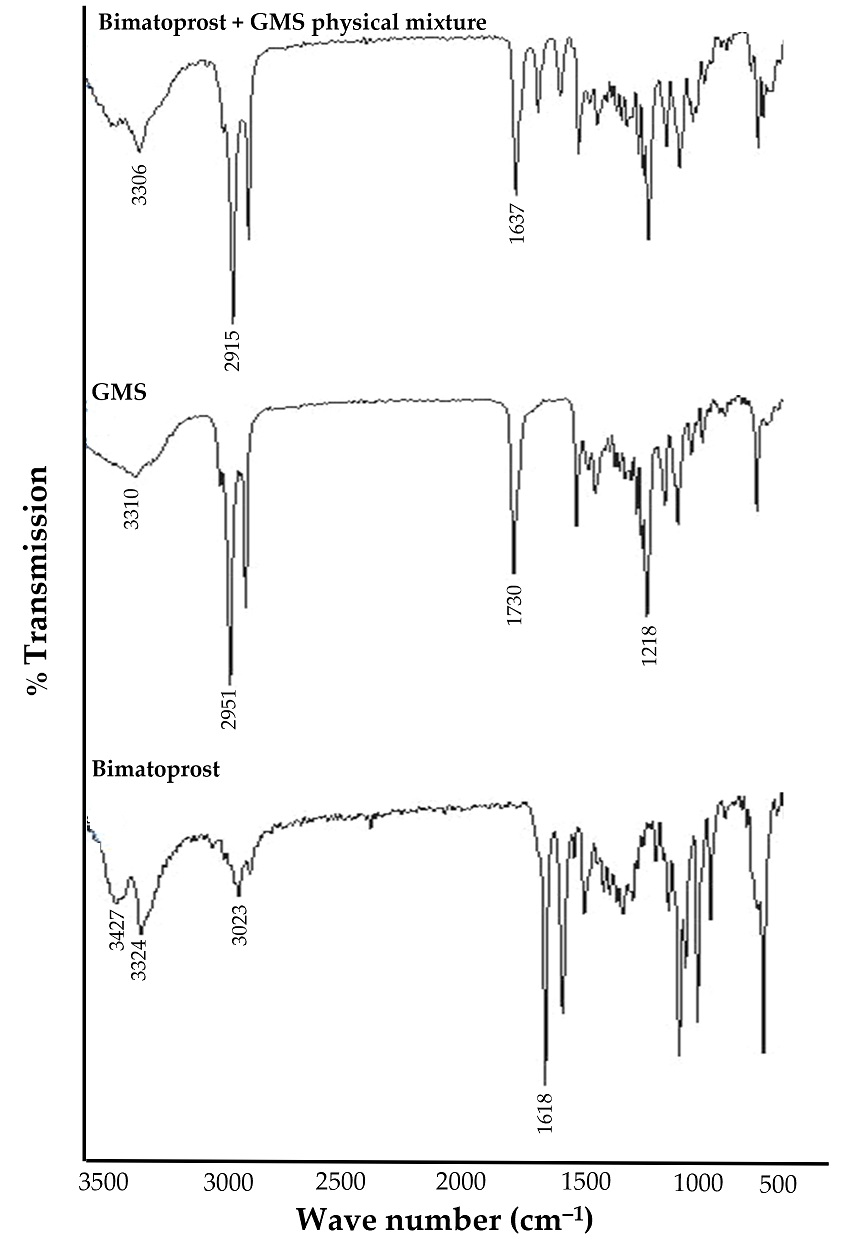
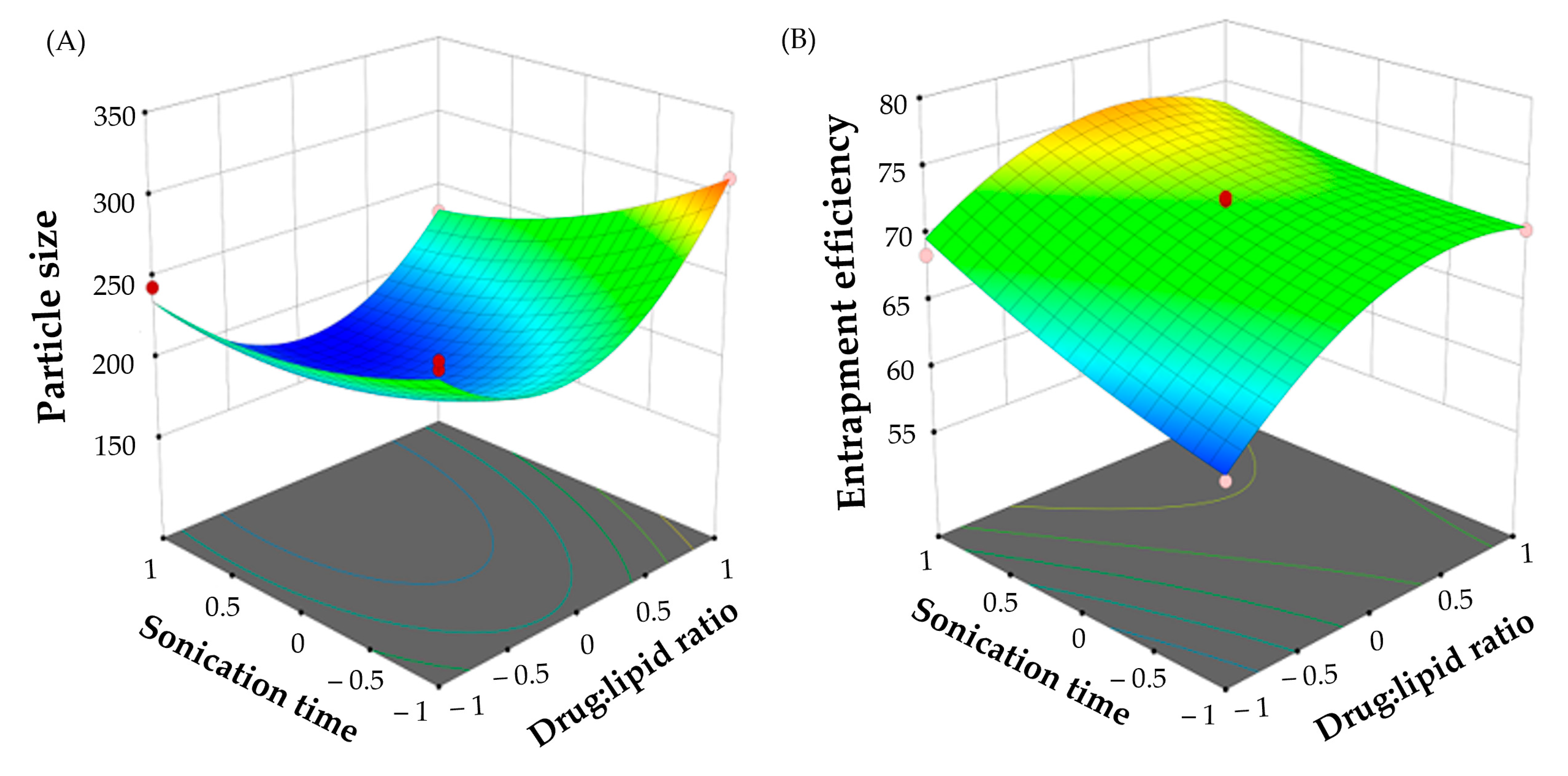
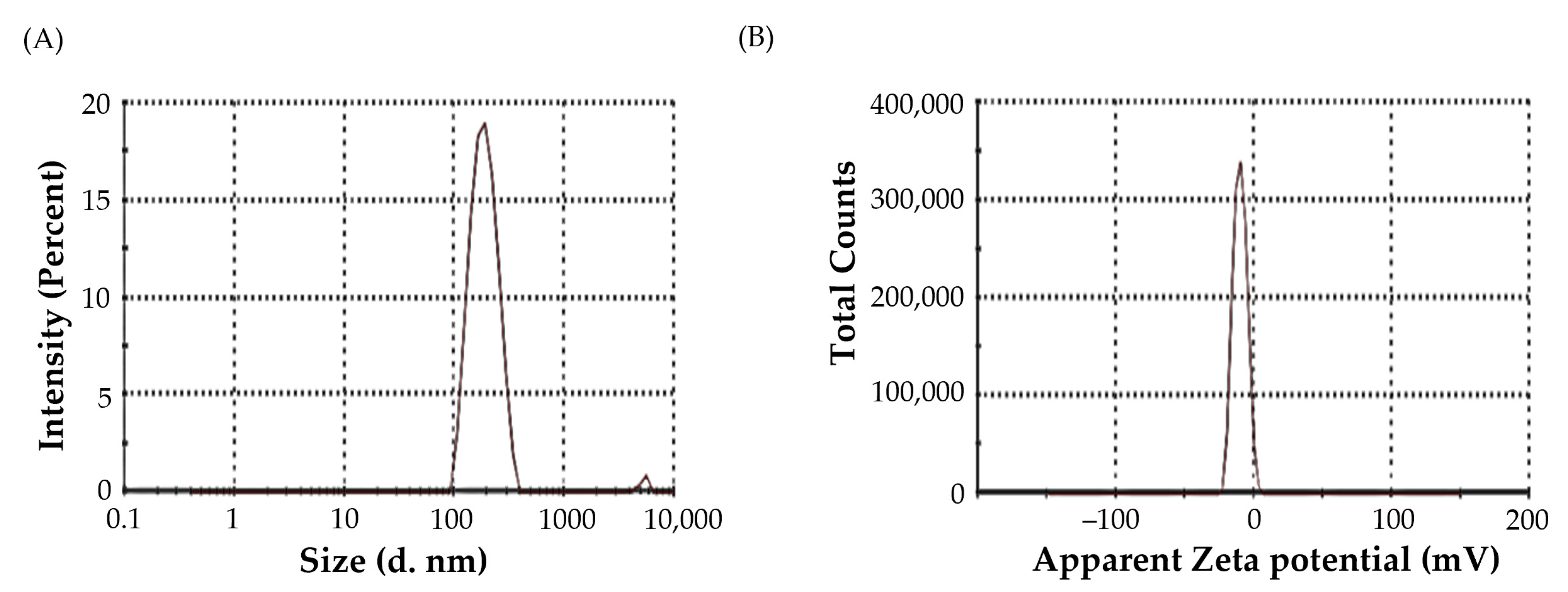
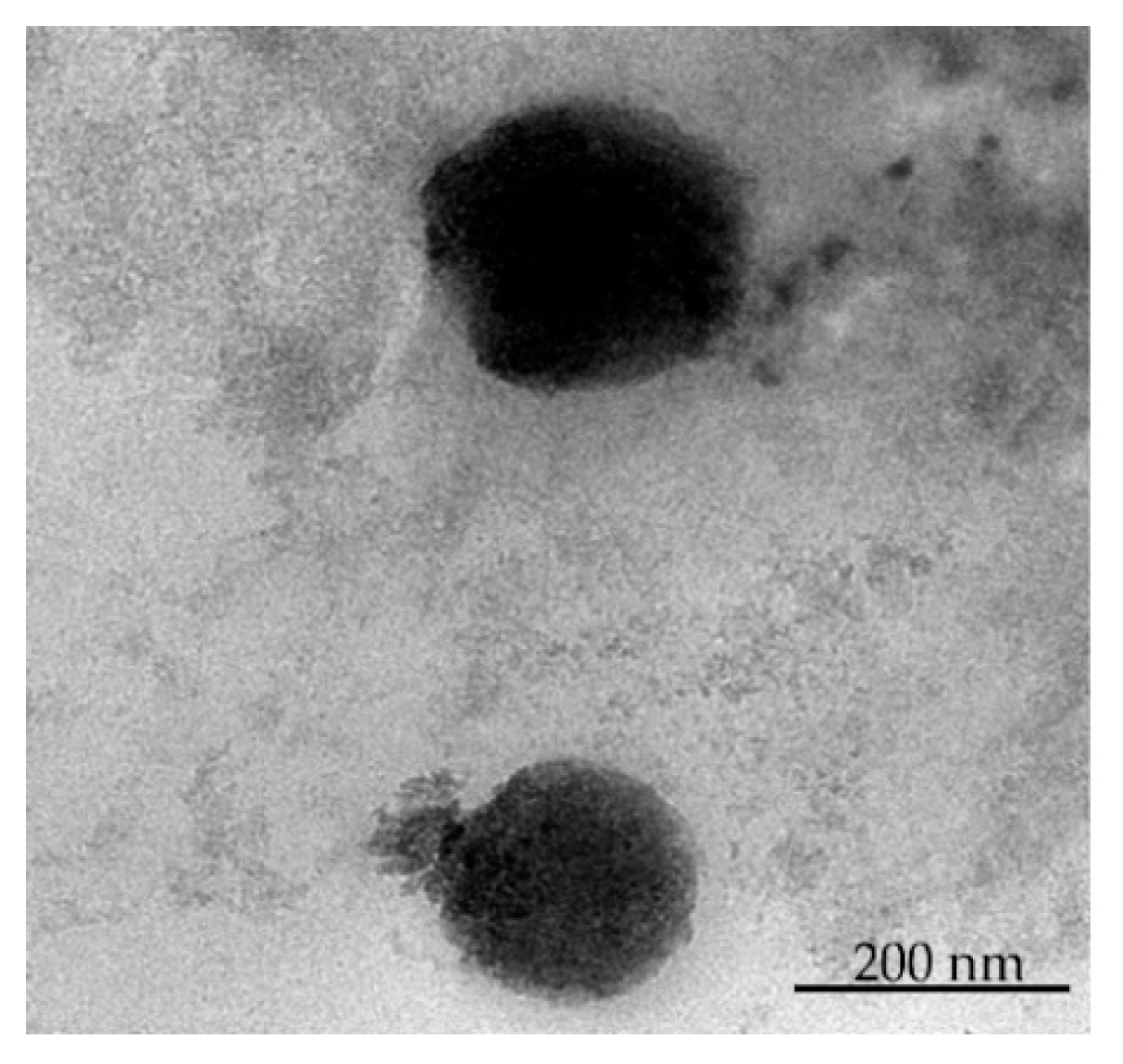
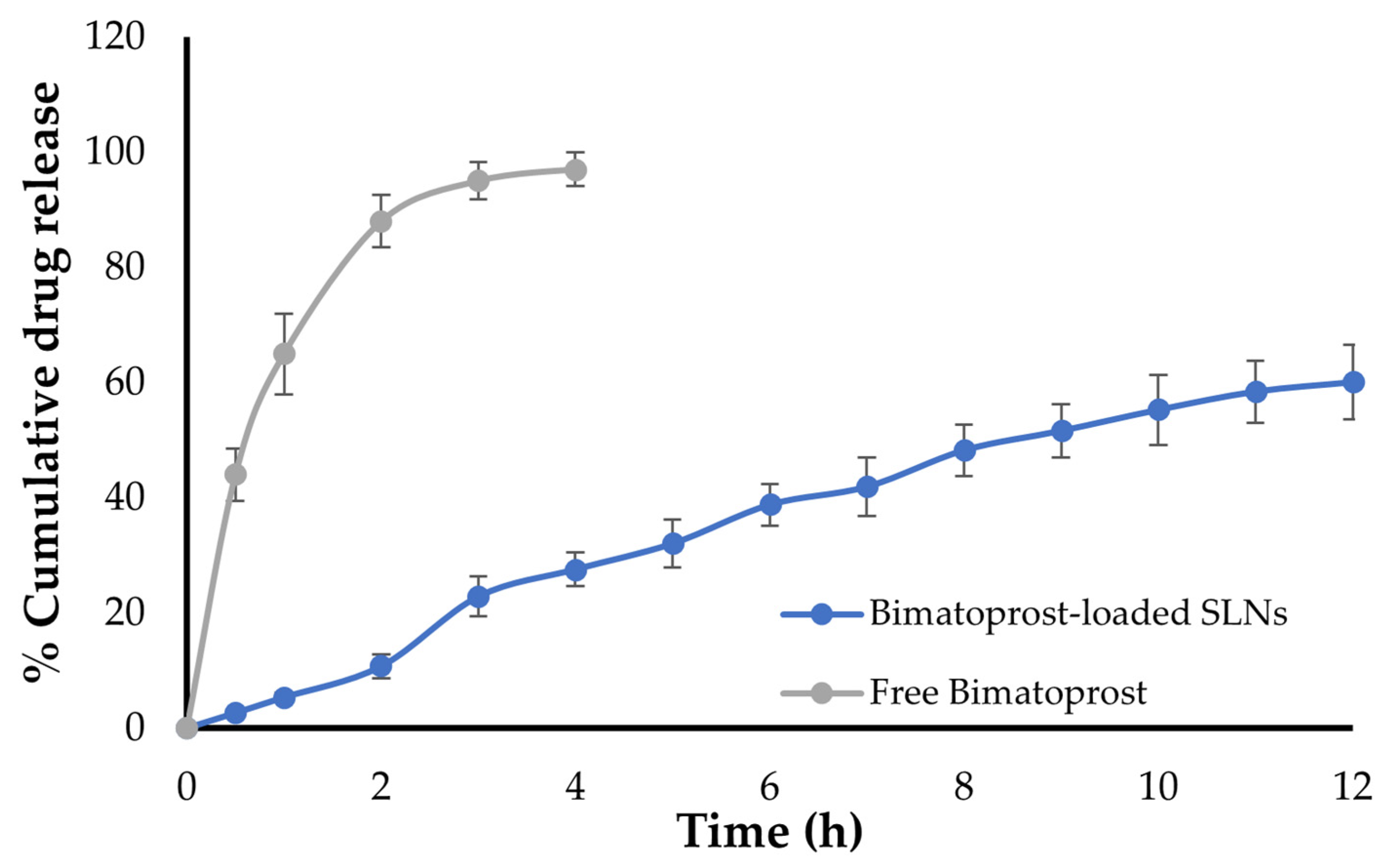
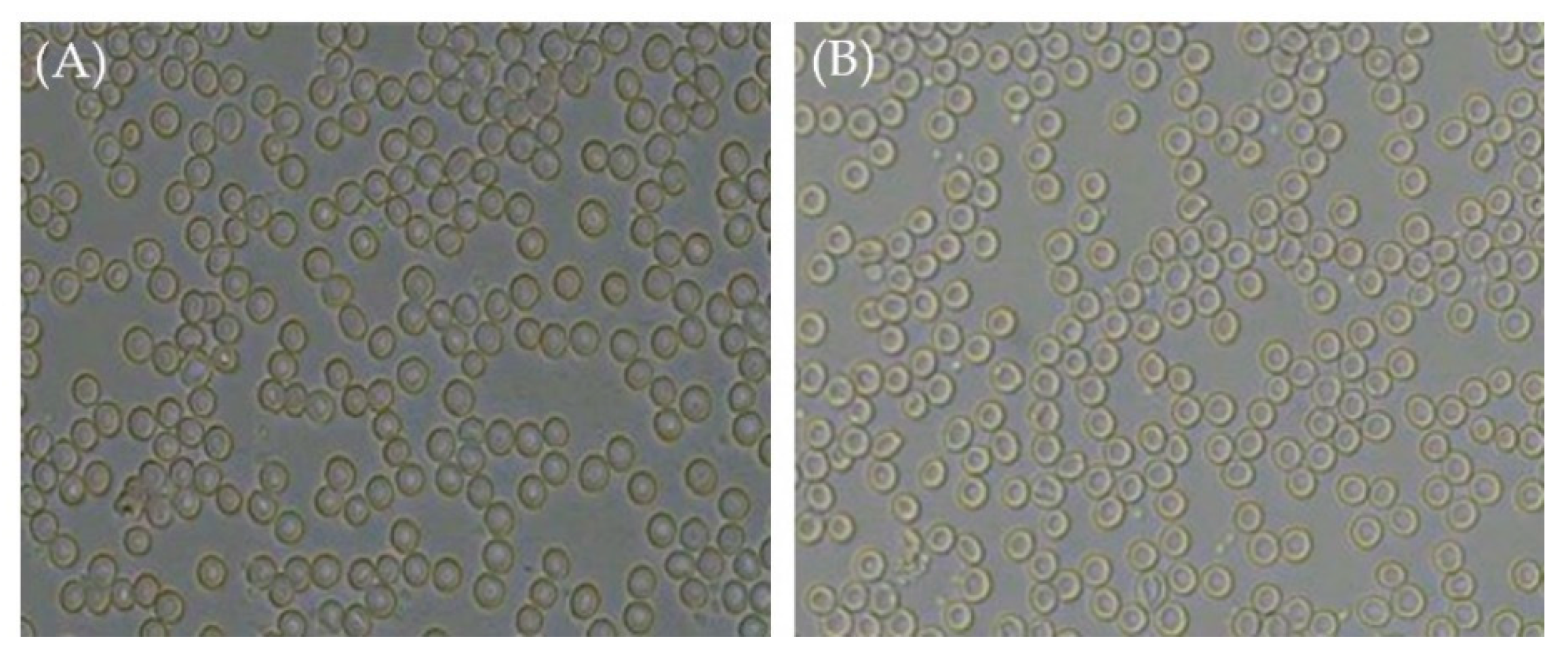
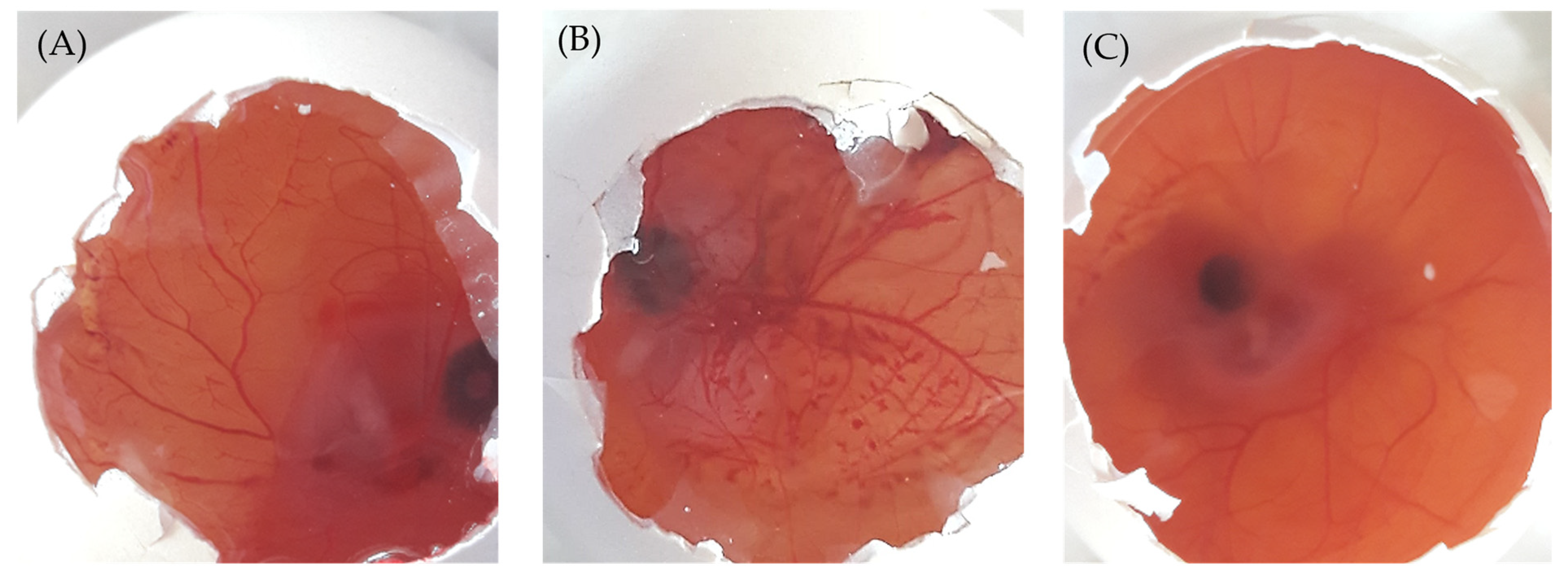
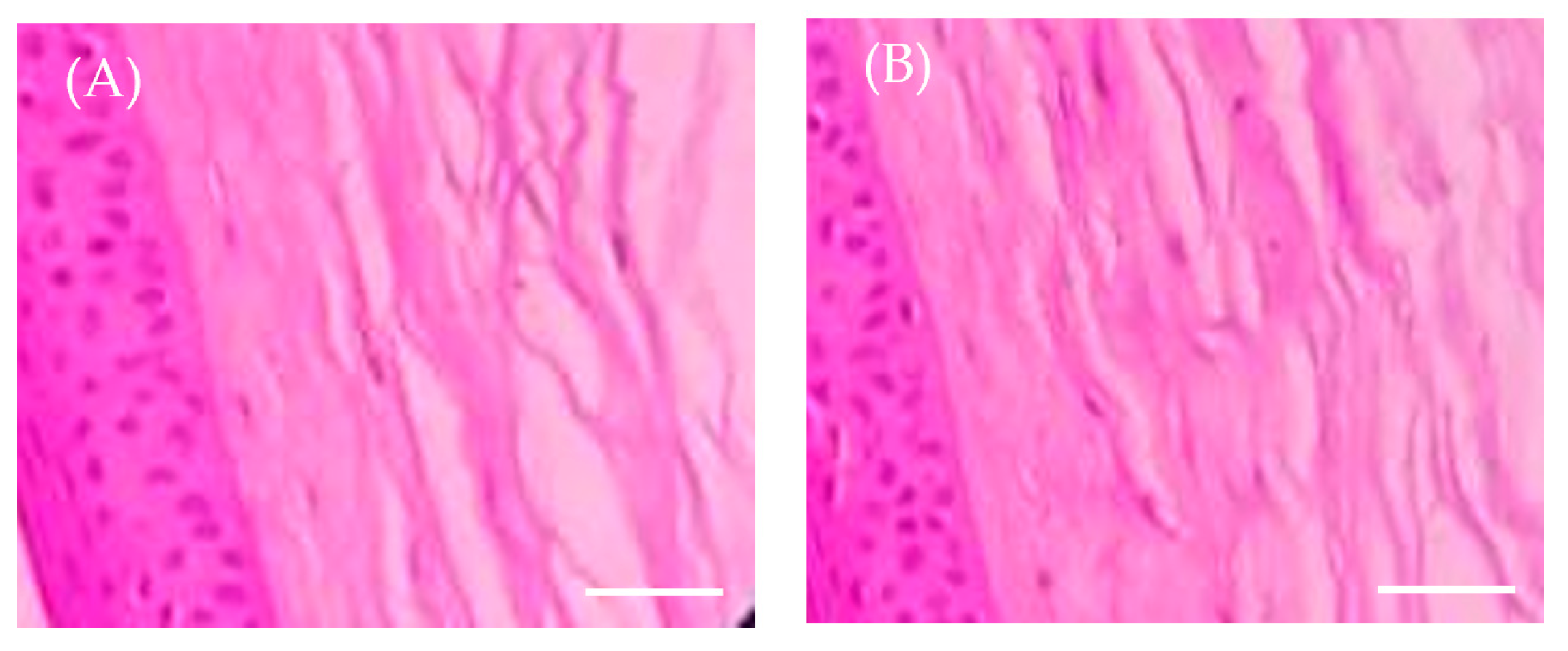
| Formula | A: Drug:Lipid Ratio (w:w) | B: Sonication Time (min) | R1: Particle Size (nm) | R2: Entrapment Efficiency (%) |
|---|---|---|---|---|
| 1 | 0 | 0 | 184.7 ± 11.4 | 72.7 ± 2.4 |
| 2 | −1 | −1 | 269.8 ± 18.2 | 61.4 ± 1.9 |
| 3 | −1 | 1 | 244.3 ± 13.7 | 68.5 ± 1.1 |
| 4 | 0 | 0 | 188.6 ± 9.5 | 71.4 ± 2.1 |
| 5 | 0 | 0 | 185.5 ± 7.6 | 72.8 ± 1.8 |
| 6 | 0 | 0 | 192.8 ± 11.1 | 70.4 ± 1.6 |
| 7 | 0 | 0 | 198.4 ± 12.4 | 72.6 ± 1.9 |
| 8 | 0 | −1.41421 | 248.2 ± 18.6 | 69.7 ± 0.9 |
| 9 | 0 | 1.41421 | 178.6 ± 9.3 | 78.6 ± 1.3 |
| 10 | 1 | −1 | 310.6 ± 19.5 | 70.4 ± 2.5 |
| 11 | 1 | 1 | 232.6 ± 11.6 | 72.3 ± 1.7 |
| 12 | 1.41421 | 0 | 322.3 ± 17.6 | 69.3 ± 0.8 |
| 13 | −1.41421 | 0 | 272.8 ± 12.3 | 60.8 ± 1.1 |
| Test Microorganism | Positive Control | Negative Control | Optimized Formulation |
|---|---|---|---|
| Staphylococcous aureus | + | − | − |
| Bacilus subtilus | + | − | − |
| Candida albicans | + | − | − |
| Asperges brasiliensis | + | − | − |
| Test Compound | Mean Irritation Score | Inference |
|---|---|---|
| Negative control (0.9% NaCl) | 0.01 ± 0.01 | No irritation |
| Optimized Bimatoprost SLNs | 0.02 ± 0.01 | No irritation |
| Positive control (1% SDS) | 15.68 ± 0.78 | Severe irritation |
| Factors | Levels, Actual (Coded) | ||
|---|---|---|---|
| Independent Factors | −1 (Low) | 0 (Medium) | +1 (High) |
| A = Drug:lipid ratio (w:w) | 1:1 | 1:3 | 1:5 |
| B = Sonication time (in) | 5 | 10 | 15 |
| Dependent factors | |||
| Particle size (nm) (R1) | |||
| Entrapment efficiency % (R2) | |||
| Irritation Score | Mean Score Value | Level of Irritation |
|---|---|---|
| 0–0.9 | 0 | No irritation |
| 1–4.9 | 1 | Slight irritation |
| 5–8.9 | 2 | Moderate irritation |
| 9–21 | 3 | Severe irritation |
Disclaimer/Publisher’s Note: The statements, opinions and data contained in all publications are solely those of the individual author(s) and contributor(s) and not of MDPI and/or the editor(s). MDPI and/or the editor(s) disclaim responsibility for any injury to people or property resulting from any ideas, methods, instructions or products referred to in the content. |
© 2023 by the authors. Licensee MDPI, Basel, Switzerland. This article is an open access article distributed under the terms and conditions of the Creative Commons Attribution (CC BY) license (https://creativecommons.org/licenses/by/4.0/).
Share and Cite
Satyanarayana, S.D.; Abu Lila, A.S.; Moin, A.; Moglad, E.H.; Khafagy, E.-S.; Alotaibi, H.F.; Obaidullah, A.J.; Charyulu, R.N. Ocular Delivery of Bimatoprost-Loaded Solid Lipid Nanoparticles for Effective Management of Glaucoma. Pharmaceuticals 2023, 16, 1001. https://doi.org/10.3390/ph16071001
Satyanarayana SD, Abu Lila AS, Moin A, Moglad EH, Khafagy E-S, Alotaibi HF, Obaidullah AJ, Charyulu RN. Ocular Delivery of Bimatoprost-Loaded Solid Lipid Nanoparticles for Effective Management of Glaucoma. Pharmaceuticals. 2023; 16(7):1001. https://doi.org/10.3390/ph16071001
Chicago/Turabian StyleSatyanarayana, Sandeep Divate, Amr Selim Abu Lila, Afrasim Moin, Ehssan H. Moglad, El-Sayed Khafagy, Hadil Faris Alotaibi, Ahmad J. Obaidullah, and Rompicherla Narayana Charyulu. 2023. "Ocular Delivery of Bimatoprost-Loaded Solid Lipid Nanoparticles for Effective Management of Glaucoma" Pharmaceuticals 16, no. 7: 1001. https://doi.org/10.3390/ph16071001
APA StyleSatyanarayana, S. D., Abu Lila, A. S., Moin, A., Moglad, E. H., Khafagy, E.-S., Alotaibi, H. F., Obaidullah, A. J., & Charyulu, R. N. (2023). Ocular Delivery of Bimatoprost-Loaded Solid Lipid Nanoparticles for Effective Management of Glaucoma. Pharmaceuticals, 16(7), 1001. https://doi.org/10.3390/ph16071001









